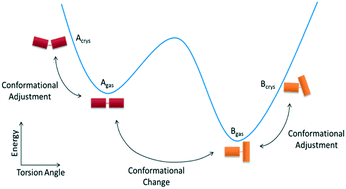Is it usual to be unusual? An investigation into molecular conformations in organic crystals†
Abstract
Molecular conformations can influence the structure and properties of crystalline solids. Important solid-state phenomena such as conformational polymorphism arise from the ability of compounds to crystallise in different conformers. A method to readily identify whether or not a crystal conformation is highly adjusted or may correspond to a rare conformer is, thus, very desirable. We present a new way of identifying unusual conformations in molecular crystals from distributions of torsions in the Cambridge Structural Database (CSD). Our method allows for identification of torsion unusualness with regards to conformational adjustment and conformational change. As part of this method, two new parameters derived from CSD distributions are calculated: Padjust and Pchange. These parameters were tested against DFT calculations for the derivation of meaningful CSD probability thresholds which allow for the identification of unusual torsions. The developed method was then used to investigate unusual torsions in molecular crystals. We found that between 10–13% of torsions in the CSD are unusual and that unusual conformational adjustment is significantly more common than unusual conformational change.

- This article is part of the themed collections: Database Analysis and The Cambridge Structural Database - A wealth of knowledge gained from a million structures


 Please wait while we load your content...
Please wait while we load your content...